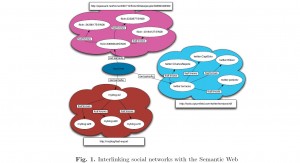Social networking sites now are limited to the management of user accounts that are present in their own network. But there is a need to address the cross networking linkage where a user doesn’t have to bother about the multiple login credentials for logging into one of the other social websites.
To enable this functionality to happen, we need to give access to the multiple sites, in terms of 1) identification of personal profiles and friend networks and 2) user contents that are expressed on each site. This task is made easy by the representation mechanism that connects people. The semantic web finds a solution to the above mentioned problems by FOAF and SIOC.
The FOAF project provides a way of representing social network data in a machine readable way because for each of the people and their relationships in the social web sites there is always some ontology that is defined. That means that every such site which exports the RDF related information has a unique FOAF representation of the users.
For example, each person in a network has a FOAF instance like :- “foaf:Person” with a unique URI. Each of those instance will have some properties like “foaf:name”, “foaf:nickname” and ”foaf:birthday”.
The following code snippet will give a idea about the above mentioned points for the profile created in flickr using FOAF:-
flickr:33669349@N00 a foaf:Person ;
foaf:name “Deep Ray” ;
foaf:mbox_sha1sum “528b95cc44060ceea571d7498a9fd2c7e3ca8a4c” .
foaf:knows flickr:32233977@N00 .
In order to consolidate the data of the distributed profiles from the different sites, we take the help of the property such as “owl:sameAs” which is used to identify two resources that have completely two different URI but they belong to one person who is having accounts at different social web sites. Thus people can refer to one main FOAF URI which can be described by other automatically generated FOAF profile which links to other existing profile.
:me owl:sameAs flickr:33669349@N00 ;
owl:sameAs twitter:terraces ;
owl:sameAs facebook:foaf-607513040.rdf#me .
The other way of doing this is by using the concept of SIOC where online community forms such as blogs,message boards and mailing lists are described and linked. SIOC also lets developers to link user created content items to other related items, to people and to topics.
For example, a SIOC exporter plugin for a blog engine would create a SIOC
RDF representation of every blog post and comment, including information
about:
– the content of a post (sioc:content)
– the author (sioc:has creator)
– the creation / update date (dct:created / dct:updated)
– tags and categories (sioc:topic)
– all comments on the post (sioc:has reply)
– information about the container blog (sioc:has container)
References: – Uldis Bojars, Alexandre Passant, John G. Breslin, Stefan Decker. Social Network and Data Portability using Semantic Web Technologies.

